Game steering wheels and joysticks - XXI century technologies in gaming devices
The article was written for Computer Build magazine and therefore the text is deliberately simplified. The magazine did not accept the article, here I publish it here.
The 20th century was the century of analog technology. Radio, television, telephony - everything was built on creating audio and video information at the place of transmission of electrical analogs and recreating it at the reception site. It was the age of lamps, relays and potentiometers.
The birth of the transistor gave rise to the century of semiconductors, and semiconductors gave the world digital technology and by the age of XXI digital technologies are increasingly replacing analog from our lives. Not so long left to live analog television, analog telephony quickly losing ground in front of digital cellular communication. There is not the slightest doubt that the 21st century will be the century of digital technology and semiconductors.
Let's see how the global evolution of technology has affected the devices for managing computer games.
Consider 2 large classes of gaming devices - joysticks and game controls . We will not consider the appearance and ergonomics of devices - this is abundantly stated in a huge number of articles in magazines and the network, but look inside and try to understand where the technologies are moving in the devices of the market leaders.
Apparently, the joysticks were the first devices to control computer games. The first joysticks were very primitive - in fact, they were just 4 buttons assembled in one case, which were pressed when the joystick knob was tilted to one side or the other. Often, there was not even any interface for connecting such joysticks, and the device’s contacts simply directly soldered to the keyboard buttons.
I think many still remember these joysticks for the ZX Spectrum:

')
They are called "discrete", because they are able to give only values 0 or 1, on / off.
With the advent of the IBM PC, the first serious flight simulators appeared. For example, the F-19 Stealth Fighter game gave a ticket to the sky to many virtual pilots.
Of course, a surge of interest in virtual flights could not pass by the manufacturers of gaming devices.
And so the joysticks for the IBM PC began to appear.
A typical representative of the joysticks of those years:
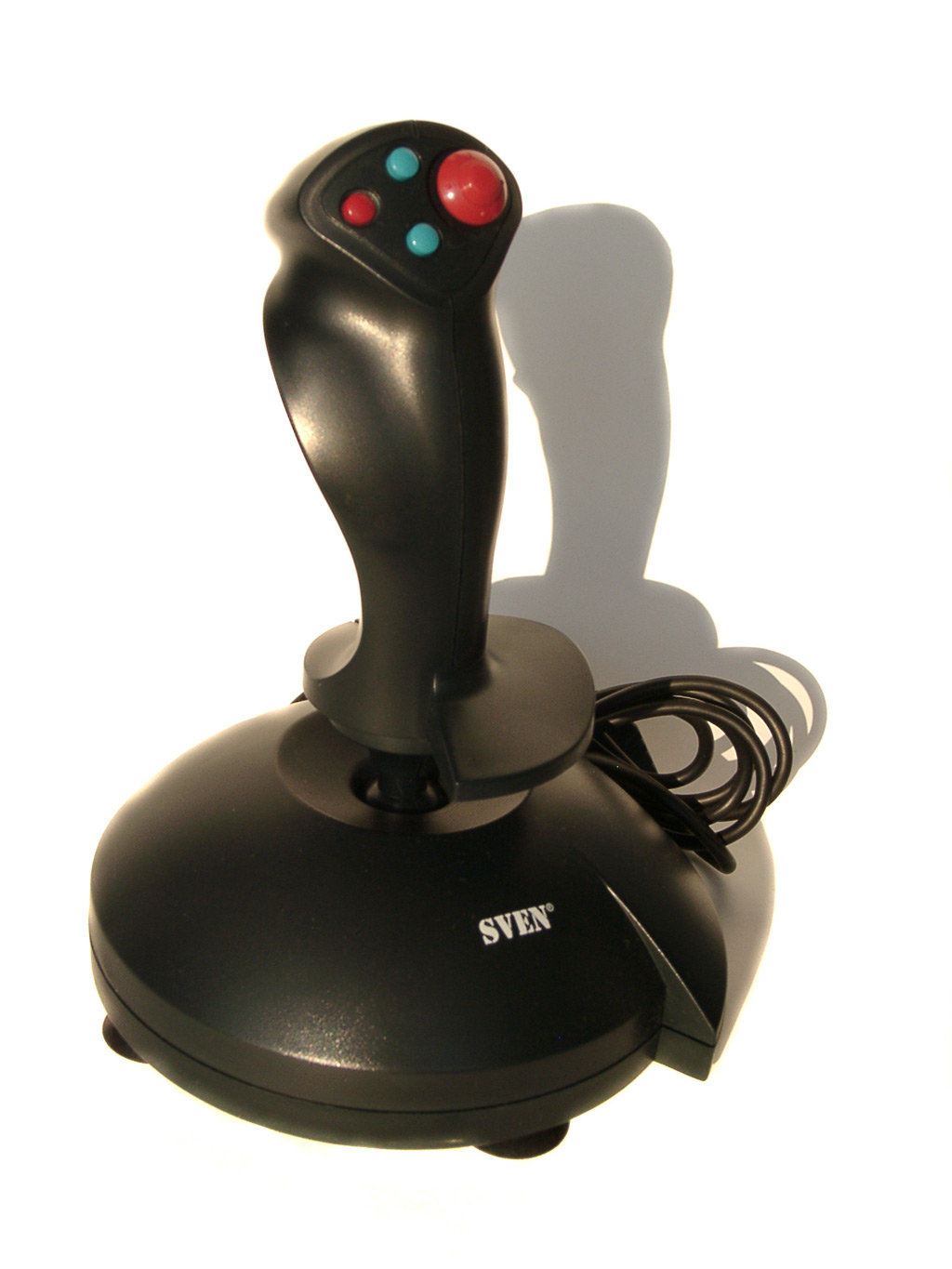
What is interesting - these models are still sold!
Unlike discrete joysticks, these joysticks were ANALOG. Now, rejecting the handle, the user received not 0 and 1 at the output, but a range of values from 0 to 255, and analog sensors - potentiometers - were located inside. The range of values that the sensor gave out to the game was related to the controller's bit depth - 8 bit.
Analog axes gave players the opportunity to control games much more accurately, bringing the control of a virtual plane to a real one.
However, the first problems immediately came to light. The angle of deflection of the handle is determined using a potentiometer mounted on the axis of rotation. We recall the school course of physics - the potentiometer is built on the friction of the engine on a resistive layer:
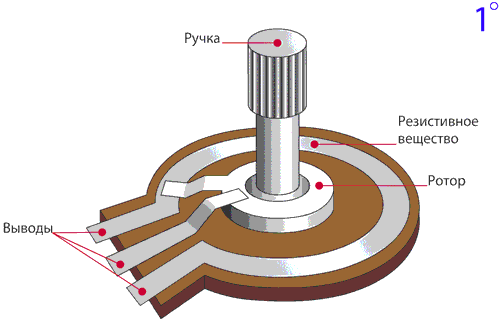
The change in resistance between the extreme and central conclusion determines the angle to which the joystick handle is rejected.
Because Since the slider slides over the resistive layer, the lifetime of the potentiometer is limited by the time over which the resistive substance is erased. Manufacturers of potentiometers honestly warn about this, indicating in the characteristics of such a parameter as the "number of cycles", which the sensor will serve, roughly speaking - how many times you can turn it up to the moment when it stops working normally. For most potentiometers that are used in gaming devices, this figure ranges from 500 thousand to a million cycles. It seems that it is a lot, but let's count. On average, a player makes 1 movement per second, which means that after 500 thousand seconds of playing the device will stop working normally. And 500 thousand seconds is only 138 hours. Those. if you play 1 hour a day, less than in six months, such a joystick is guaranteed, according to all the laws of physics, it should fail.
But manufacturers of joysticks are delicately silent about this design feature, you will not see the words “Designed for 500 thousand cycles” on any joystick. But there are figures of the warranty period - from 6 to 12 months. The warranty period in this case is clearly tied to the potentiometer resource, so in the case of a joystick it is also the lifetime of the device.
The discovery for users turned out to be unpleasant - to play, so to play, and not an hour a day, it is expensive to change the joysticks every six months. What to do? The skillful hands of our citizens quickly mastered the disassembly of the joysticks and the lubrication of the potentiometers with special lubricants such as WD-40, which made it possible to prolong the life of the potentiometers.
For their part, manufacturers began to solve the problem, using more expensive potentiometers with a large resource, but it was clear that these were half measures.
It was necessary to seek a contactless solution, and it was proposed in the form of optical sensors .
The first such solution was proposed by Microsoft in the joystick Microsoft SideWinder Precision Pro. With the advent of optical sensors for mice, Microsoft tried to apply the same technology inside the joystick, but the solution was not successful and no more joysticks with such sensors were released.
A simple optical encoder (as in a normal mouse with a ball) turned out to be simpler and more reliable:
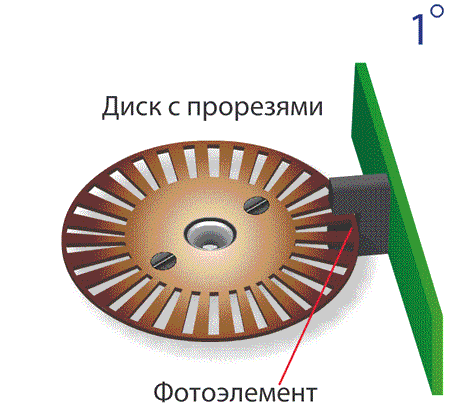
For example, the Cyborg 3D Force Stick joystick is built on this principle:


The use of such sensors made it possible to raise the resource of joysticks to a new level.
But this sensor has drawbacks. The minimum angle of rotation of the axis of the joystick is equal to the width of the slit of the encoder, and the requirements for the accuracy of the joystick grew with the advent of new flight simulators, and many players in the IL-2 Sturmovik, for example, turned out to be completely inadequate. Many players have abandoned the perpetual sensor on the optical encoder in favor of more accurate potentiometers.
The required sensor is not just contactless and durable, but also accurate.
The solution was found in magnetic sensors . From that moment on, digital semiconductor technologies of the 21st century came to gaming devices. With all confidence we can say that magnetic technology is the future of gaming sensor devices.
The first mass device on the magnetic Hall sensors was the joystick Saitek X52
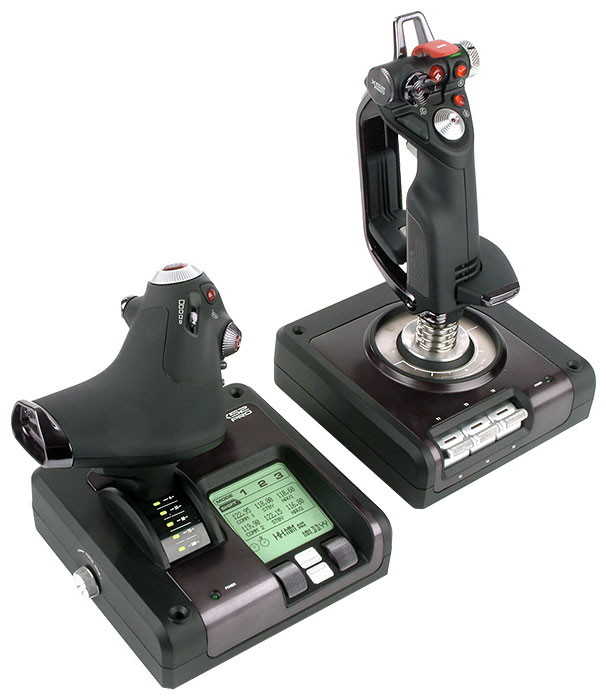
Hall sensors are designed to measure the magnetic field. Roughly speaking, the sensor can accurately determine the distance to the permanent magnet. Thus, by placing the magnets on the handle of the joystick, zooming in or removing the magnet from the sensor, you can determine how far the handle has shifted. In this case, the distance is measured with high accuracy, which is determined by the digit capacity of the controller. The 10bit controller allows you to position the joystick with an accuracy of 1024 counts per axis.
It seemed that a solution was found - a joystick was obtained on perpetual contactless sensors with high positioning accuracy. However, the first users already found out the unpleasant feature of the Hall sensors - the output data varies nonlinearly, and this leads to incorrect measurement of the joystick angle in the middle positions of the handle.
The next stage in the development of this technology was the use of 3D Hall sensors . These sensors determine not the field strength, but the direction to the source of the magnetic field. This sensor was first used in the Thrustmaster T.16000 joystick:

The new sensor is contactless and absolutely linear. Accuracy of 16,394 counts per axis leaves far behind all the joysticks that were released before.
Unfortunately, the developers of Thrustmaster T.16000 did not take into account one important point - 3D Hall is extremely sensitive to the accuracy of moving the magnet. Because they fixed it on a plastic hemisphere, the inevitable wear of the plastic leads to the fact that the magnet begins to move not in an ideal hemisphere, but with “jumps”, which leads to problems with positioning accuracy.
Logitech tried to solve this problem by installing the Logitech Flight System G940 joystick axles on bearings.
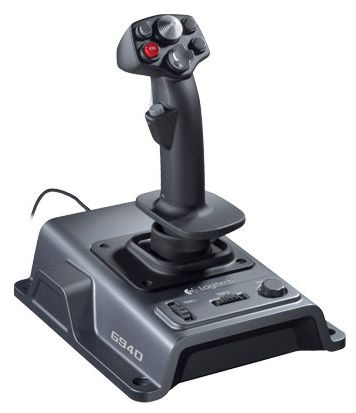

Now the magnet is guaranteed to move along an absolutely correct trajectory, without backlash and jumps, but the ill-conceived feedback system implemented on this model has scared many users away (not to mention the price of 13,000 rubles).
Radically to solve the problem of accuracy and durability of sensors, as well as the resource of mechanical parts of the joystick, Saitek decided in the model X65F :
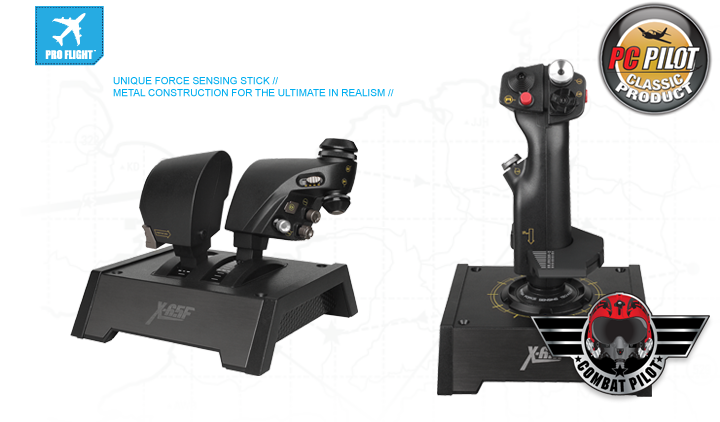
In this joystick, the handle is fixed completely motionless, the player's movements are removed from the handle with the help of strain gauges - sensors that measure pressure. The player makes an effort to handle, the load cells record the pressure and pass it into the game. Thus, the durability problem of mechanics is solved (the handle is fixed, which means it will not have any wear), the durability of the sensors - strain gauges have a huge resource, and the high-performance controller will provide accuracy. However, it will be not clear how comfortable it will be to play without rejecting the pen. The joystick is not yet sold and its capabilities are not yet tested. Most likely this joystick will remain a niche device for a small circle of fans of modern combat aircraft, since control of aircraft of the First and Second World Wars requires that the pen be deflected. But wait and see.
Let's sum up the intermediate result.
Over the past 20 years, joysticks have evolved from primitive discrete switches to high-tech devices using the most advanced technologies of the 21st century. The new joysticks use the most advanced sensors for measuring angles - magnetic, which allows you to make devices with a very large resource and the highest positioning accuracy.
Today, customers can use joysticks with all types of sensors - on potentiometers, optical encoders, Hall sensors and 3D Halls. I dare to assert that soon enough the potentiometers and optics will be a thing of the past - as soon as the magnetic sensors become cheaper, and manufacturers will take into account the errors of the first devices on the new technology.
Game wheels were born later joysticks. At first it seemed that the presence of a joystick, or even just a keyboard, would suffice for games-races. The first racing games were not distinguished by a high level of realism.
However, racing games became more and more, the physical model of cars became more complicated, and many players wanted to get a control device close to the real car. So there were the first wheels and pedals for games-racing.
The usual set for racing games consists of the steering wheel itself, a pedal unit (2, less often 3 pedals) and sometimes a gearbox unit and a handbrake.
So, with what sensors does the angle of deflection of the steering wheel and pedals measure modern mass-sold game kits for racing games? There are not so many of them as in joysticks.
The first type is, of course, a potentiometer . The overwhelming majority of gaming kits for racing games on the market today are made on potentiometers with an 8bit controller. This is natural - manufacturers simply mechanically moved the angle measurement system from the joystick to the steering wheel.
However, these devices are far from equivalent, and the main difference between the steering wheel and the joystick is the angle of rotation. If in joysticks it is usually no more than 40 degrees, then in rudders the minimum angle is 180 degrees, and the norm is 250-270 degrees. And if we talk about the full simulation of driving, the angle of rotation of the steering wheel should reach 900 degrees!
Therefore, the use of potentiometers brought in the steering wheels even more problems than in joysticks.
We remember about the problem of the limited resource of potentiometers, the wheels and pedals with such a sensor are “time bomb” - you can say for sure when it “jerks”, i.e. when the steering wheel and pedals stop working normally due to the destruction of the resistive layer.
The second problem is that if a joystick with an 8bit controller (256 values per axis) with a deflection of the handle by 40 degrees allows measuring the angle of deflection of the handle with an accuracy of 40/256 = 0.15 degrees, then the same system in the steering wheel with an angle of rotation of 250 degrees gives an accuracy of 250/256 = 1 degree. Not enough for precise control! Rotate the steering wheel at 0.5 degrees will not work.
And that is not all. Most inexpensive potentiometers operate at angles from 180 to 200 tons. What to do if the steering wheel turns 250 degrees? Manufacturers went the simplest way - the potentiometer is not installed directly on the steering axis, but connected to it via a gear. But since Such a gearbox requires a high precision fit of the gears, which is rather difficult to achieve when mass-producing inexpensive products, then the user also gets an additional backlash in a central position:
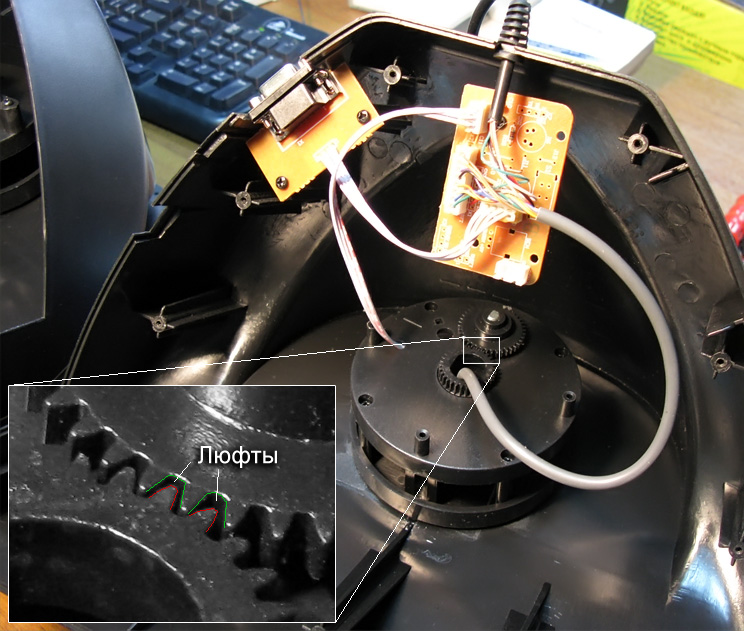
This backlash leads to the fact that in the center position of the steering wheel there is a dead zone of about 5–8 degrees, in which the steering wheel does not work at all.
In sum, the use of potentiometers in gaming wheels should be recognized as a very unfortunate decision. The only thing that justifies their use is the low price of the game set.
The second type of sensors, which are used in game controllers, are optical encoders , which we also talked about above.
They are contactless (and therefore reliable), have no restrictions on the angle of rotation, and therefore do not create problems for either turning 250 or even 900 degrees.
It would seem - this is the perfect solution for steering. But, unfortunately, everything is not as simple as it seems at first glance.
The first problem is that the optical encoder has no starting position. All he can do is pass on / off values through a certain angle of rotation. And how then to determine where the center position of the steering wheel? The steering wheel on the optical encoder requires calibration every time it is turned on.
In order for the system to know where the center position is, the steering wheel must be turned in one direction until it stops, then in the other direction until it stops, the system calculates how many slots are in front of the photocell, divides this value by 2, this will be the center.
It is logical to assign calibration work to a special actuator. As a result, the steering wheels got their own electric motor, which calibrated the steering wheel each time it was turned on, turning it back and forth. The presence of an electric motor also allowed the use of an active feedback system in the steering wheels, the so-called Force Feedback, when the steering wheel reacted to the situation in the game like the steering wheel of a real car, trying to break free from the player’s hands when driving on a rough road, when the wheels lose traction on the asphalt, the steering wheel starts to rotate gently, etc.
The next problem with an optical encoder is accuracy, which was not enough even for a joystick with its 40 degrees of rotation. As we remember, the minimum angle by which you can turn the steering wheel is determined by the width of the slot. To improve accuracy, you can:
a) make the cut ỳ already, and the disk itself is larger
b) assume that, for example, 10 slots = 1 degree of rotation in the game, then the minimum angle of rotation of the game steering wheel will be 0.1 degrees, which is quite enough for precise control.
None of the manufacturers went the first way - a large disk is an increase in size, narrowing of the slots is a problem with the photocell work, although such a solution would allow installing a disk with slots directly on the steering axis, no reducer would be required.
All went the second way - they began to install a small disk with wide slots, but not directly on the steering axis, but through a gear reducer.
It seems that the problem of steering precision and durability has been solved, but what to do with the pedals? Places in the pedal case are incomparably smaller than in the steering case. It is not a trivial task to install an optical disk and a reducer in the pedals, especially considering the struggle for the price of the final product. Cheap pedals with precise gear will not be exact. As a result, most manufacturers stopped at a compromise version - a steering wheel on optics, pedals on potentiometers. As a result, the users of these rudders also thoroughly studied the internal structure of their pedals and potentiometers in them and write instructions to other users how to disassemble the potentiometers and lubricate them with WD-40.
Today there is only one model on the market - the Saitek R660GT, in which optical encoders are installed in the steering wheel and pedals. But it had to be paid for with accuracy. The steering wheel has a total of 128 counts at 270 degrees of rotation, the pedals - 60 counts at 15 degrees.

All other models, up to the very expensive Logitech G25 and G27, have pedals on potentiometers .
Thus, the use of a seemingly simple optical sensor led to a complication in the design of the steering wheel - an electric motor, a complex controller, an additional power supply unit and a reducer were needed, and besides, few people managed to put optics on the pedals.
It seems logical that the solution to the problems of durability and accuracy of the steering wheel and pedals lies, as well as that of joysticks, in the field of magnetic sensors - they are both compact and highly accurate.
However, it was impossible to directly transfer the joystick technology to the steering wheels - Hall sensors, which are used in joysticks, are not applicable to the steering wheels. For a very commonplace reason - they cannot measure angles greater than 45 degrees.
It seems logical to use an optical sensor in the steering wheel, and Hall sensors in the pedals, but splicing optical and magnetic technologies in one device will lead to a dramatic complication of the controller, but it is not so easy anyway, because it must also control the electric motor.
But every problem has a solution and it is found. Magnetic sensors capable of measuring large angles have been created for a long time and have been successfully used in the automotive industry. However, their use in gaming devices is hampered by the high price, for example, the contactless angle of rotation sensor HRS100SSAB090 from HONEYWELL costs from $ 30, and at least 3 pieces should be used on the steering wheel.
For now, only Gametrix , which recently entered the Russian market, has been able to solve this problem.
In the first model, called Gametrix Viper , and on the steering wheel and on the pedals installed contactless magnetic sensors, called MaRS. These sensors have an infinite resource, because there are no rubbing parts in them.

The sensors are based on magnetic resistors from NXP-Philips, which have long been successfully used in the automotive industry.
They allow you to measure any angles with the highest accuracy. For example, the 12bit controller Gametrix Viper allows you to measure the angles of rotation of the steering wheel with an accuracy of 0.05 degrees!
I think it would not be an exaggeration to say that, like in game wheels, as in joysticks, the future belongs to magnetic technologies.
Progress is happening before our eyes, technologies replace each other faster and faster.In the gaming devices market today, we are seeing an amazing situation: all generations of gaming devices are represented in stores, from primitive joysticks and steering wheels of the early 90s to devices using the most advanced technologies of the 21st century.
I hope this article will help you make the right choice when buying.
Sorry for the big pictures, there’s no time to press each one manually, and I don’t know how to automate the process.
Schemes taken from a respected Bumburum here . I hope he will forgive me for this.
The 20th century was the century of analog technology. Radio, television, telephony - everything was built on creating audio and video information at the place of transmission of electrical analogs and recreating it at the reception site. It was the age of lamps, relays and potentiometers.
The birth of the transistor gave rise to the century of semiconductors, and semiconductors gave the world digital technology and by the age of XXI digital technologies are increasingly replacing analog from our lives. Not so long left to live analog television, analog telephony quickly losing ground in front of digital cellular communication. There is not the slightest doubt that the 21st century will be the century of digital technology and semiconductors.
Let's see how the global evolution of technology has affected the devices for managing computer games.
Consider 2 large classes of gaming devices - joysticks and game controls . We will not consider the appearance and ergonomics of devices - this is abundantly stated in a huge number of articles in magazines and the network, but look inside and try to understand where the technologies are moving in the devices of the market leaders.
Joysticks
Apparently, the joysticks were the first devices to control computer games. The first joysticks were very primitive - in fact, they were just 4 buttons assembled in one case, which were pressed when the joystick knob was tilted to one side or the other. Often, there was not even any interface for connecting such joysticks, and the device’s contacts simply directly soldered to the keyboard buttons.
I think many still remember these joysticks for the ZX Spectrum:

')
They are called "discrete", because they are able to give only values 0 or 1, on / off.
With the advent of the IBM PC, the first serious flight simulators appeared. For example, the F-19 Stealth Fighter game gave a ticket to the sky to many virtual pilots.
Of course, a surge of interest in virtual flights could not pass by the manufacturers of gaming devices.
And so the joysticks for the IBM PC began to appear.
A typical representative of the joysticks of those years:

What is interesting - these models are still sold!
Unlike discrete joysticks, these joysticks were ANALOG. Now, rejecting the handle, the user received not 0 and 1 at the output, but a range of values from 0 to 255, and analog sensors - potentiometers - were located inside. The range of values that the sensor gave out to the game was related to the controller's bit depth - 8 bit.
Analog axes gave players the opportunity to control games much more accurately, bringing the control of a virtual plane to a real one.
However, the first problems immediately came to light. The angle of deflection of the handle is determined using a potentiometer mounted on the axis of rotation. We recall the school course of physics - the potentiometer is built on the friction of the engine on a resistive layer:

The change in resistance between the extreme and central conclusion determines the angle to which the joystick handle is rejected.
Because Since the slider slides over the resistive layer, the lifetime of the potentiometer is limited by the time over which the resistive substance is erased. Manufacturers of potentiometers honestly warn about this, indicating in the characteristics of such a parameter as the "number of cycles", which the sensor will serve, roughly speaking - how many times you can turn it up to the moment when it stops working normally. For most potentiometers that are used in gaming devices, this figure ranges from 500 thousand to a million cycles. It seems that it is a lot, but let's count. On average, a player makes 1 movement per second, which means that after 500 thousand seconds of playing the device will stop working normally. And 500 thousand seconds is only 138 hours. Those. if you play 1 hour a day, less than in six months, such a joystick is guaranteed, according to all the laws of physics, it should fail.
But manufacturers of joysticks are delicately silent about this design feature, you will not see the words “Designed for 500 thousand cycles” on any joystick. But there are figures of the warranty period - from 6 to 12 months. The warranty period in this case is clearly tied to the potentiometer resource, so in the case of a joystick it is also the lifetime of the device.
The discovery for users turned out to be unpleasant - to play, so to play, and not an hour a day, it is expensive to change the joysticks every six months. What to do? The skillful hands of our citizens quickly mastered the disassembly of the joysticks and the lubrication of the potentiometers with special lubricants such as WD-40, which made it possible to prolong the life of the potentiometers.
For their part, manufacturers began to solve the problem, using more expensive potentiometers with a large resource, but it was clear that these were half measures.
It was necessary to seek a contactless solution, and it was proposed in the form of optical sensors .
The first such solution was proposed by Microsoft in the joystick Microsoft SideWinder Precision Pro. With the advent of optical sensors for mice, Microsoft tried to apply the same technology inside the joystick, but the solution was not successful and no more joysticks with such sensors were released.
A simple optical encoder (as in a normal mouse with a ball) turned out to be simpler and more reliable:

For example, the Cyborg 3D Force Stick joystick is built on this principle:


The use of such sensors made it possible to raise the resource of joysticks to a new level.
But this sensor has drawbacks. The minimum angle of rotation of the axis of the joystick is equal to the width of the slit of the encoder, and the requirements for the accuracy of the joystick grew with the advent of new flight simulators, and many players in the IL-2 Sturmovik, for example, turned out to be completely inadequate. Many players have abandoned the perpetual sensor on the optical encoder in favor of more accurate potentiometers.
The required sensor is not just contactless and durable, but also accurate.
The solution was found in magnetic sensors . From that moment on, digital semiconductor technologies of the 21st century came to gaming devices. With all confidence we can say that magnetic technology is the future of gaming sensor devices.
The first mass device on the magnetic Hall sensors was the joystick Saitek X52

Hall sensors are designed to measure the magnetic field. Roughly speaking, the sensor can accurately determine the distance to the permanent magnet. Thus, by placing the magnets on the handle of the joystick, zooming in or removing the magnet from the sensor, you can determine how far the handle has shifted. In this case, the distance is measured with high accuracy, which is determined by the digit capacity of the controller. The 10bit controller allows you to position the joystick with an accuracy of 1024 counts per axis.
It seemed that a solution was found - a joystick was obtained on perpetual contactless sensors with high positioning accuracy. However, the first users already found out the unpleasant feature of the Hall sensors - the output data varies nonlinearly, and this leads to incorrect measurement of the joystick angle in the middle positions of the handle.
The next stage in the development of this technology was the use of 3D Hall sensors . These sensors determine not the field strength, but the direction to the source of the magnetic field. This sensor was first used in the Thrustmaster T.16000 joystick:

The new sensor is contactless and absolutely linear. Accuracy of 16,394 counts per axis leaves far behind all the joysticks that were released before.
Unfortunately, the developers of Thrustmaster T.16000 did not take into account one important point - 3D Hall is extremely sensitive to the accuracy of moving the magnet. Because they fixed it on a plastic hemisphere, the inevitable wear of the plastic leads to the fact that the magnet begins to move not in an ideal hemisphere, but with “jumps”, which leads to problems with positioning accuracy.
Logitech tried to solve this problem by installing the Logitech Flight System G940 joystick axles on bearings.

Now the magnet is guaranteed to move along an absolutely correct trajectory, without backlash and jumps, but the ill-conceived feedback system implemented on this model has scared many users away (not to mention the price of 13,000 rubles).
Radically to solve the problem of accuracy and durability of sensors, as well as the resource of mechanical parts of the joystick, Saitek decided in the model X65F :

In this joystick, the handle is fixed completely motionless, the player's movements are removed from the handle with the help of strain gauges - sensors that measure pressure. The player makes an effort to handle, the load cells record the pressure and pass it into the game. Thus, the durability problem of mechanics is solved (the handle is fixed, which means it will not have any wear), the durability of the sensors - strain gauges have a huge resource, and the high-performance controller will provide accuracy. However, it will be not clear how comfortable it will be to play without rejecting the pen. The joystick is not yet sold and its capabilities are not yet tested. Most likely this joystick will remain a niche device for a small circle of fans of modern combat aircraft, since control of aircraft of the First and Second World Wars requires that the pen be deflected. But wait and see.
Let's sum up the intermediate result.
Over the past 20 years, joysticks have evolved from primitive discrete switches to high-tech devices using the most advanced technologies of the 21st century. The new joysticks use the most advanced sensors for measuring angles - magnetic, which allows you to make devices with a very large resource and the highest positioning accuracy.
Today, customers can use joysticks with all types of sensors - on potentiometers, optical encoders, Hall sensors and 3D Halls. I dare to assert that soon enough the potentiometers and optics will be a thing of the past - as soon as the magnetic sensors become cheaper, and manufacturers will take into account the errors of the first devices on the new technology.
Game steering wheels
Game wheels were born later joysticks. At first it seemed that the presence of a joystick, or even just a keyboard, would suffice for games-races. The first racing games were not distinguished by a high level of realism.
However, racing games became more and more, the physical model of cars became more complicated, and many players wanted to get a control device close to the real car. So there were the first wheels and pedals for games-racing.
The usual set for racing games consists of the steering wheel itself, a pedal unit (2, less often 3 pedals) and sometimes a gearbox unit and a handbrake.
So, with what sensors does the angle of deflection of the steering wheel and pedals measure modern mass-sold game kits for racing games? There are not so many of them as in joysticks.
The first type is, of course, a potentiometer . The overwhelming majority of gaming kits for racing games on the market today are made on potentiometers with an 8bit controller. This is natural - manufacturers simply mechanically moved the angle measurement system from the joystick to the steering wheel.
However, these devices are far from equivalent, and the main difference between the steering wheel and the joystick is the angle of rotation. If in joysticks it is usually no more than 40 degrees, then in rudders the minimum angle is 180 degrees, and the norm is 250-270 degrees. And if we talk about the full simulation of driving, the angle of rotation of the steering wheel should reach 900 degrees!
Therefore, the use of potentiometers brought in the steering wheels even more problems than in joysticks.
We remember about the problem of the limited resource of potentiometers, the wheels and pedals with such a sensor are “time bomb” - you can say for sure when it “jerks”, i.e. when the steering wheel and pedals stop working normally due to the destruction of the resistive layer.
The second problem is that if a joystick with an 8bit controller (256 values per axis) with a deflection of the handle by 40 degrees allows measuring the angle of deflection of the handle with an accuracy of 40/256 = 0.15 degrees, then the same system in the steering wheel with an angle of rotation of 250 degrees gives an accuracy of 250/256 = 1 degree. Not enough for precise control! Rotate the steering wheel at 0.5 degrees will not work.
And that is not all. Most inexpensive potentiometers operate at angles from 180 to 200 tons. What to do if the steering wheel turns 250 degrees? Manufacturers went the simplest way - the potentiometer is not installed directly on the steering axis, but connected to it via a gear. But since Such a gearbox requires a high precision fit of the gears, which is rather difficult to achieve when mass-producing inexpensive products, then the user also gets an additional backlash in a central position:

This backlash leads to the fact that in the center position of the steering wheel there is a dead zone of about 5–8 degrees, in which the steering wheel does not work at all.
In sum, the use of potentiometers in gaming wheels should be recognized as a very unfortunate decision. The only thing that justifies their use is the low price of the game set.
The second type of sensors, which are used in game controllers, are optical encoders , which we also talked about above.
They are contactless (and therefore reliable), have no restrictions on the angle of rotation, and therefore do not create problems for either turning 250 or even 900 degrees.
It would seem - this is the perfect solution for steering. But, unfortunately, everything is not as simple as it seems at first glance.
The first problem is that the optical encoder has no starting position. All he can do is pass on / off values through a certain angle of rotation. And how then to determine where the center position of the steering wheel? The steering wheel on the optical encoder requires calibration every time it is turned on.
In order for the system to know where the center position is, the steering wheel must be turned in one direction until it stops, then in the other direction until it stops, the system calculates how many slots are in front of the photocell, divides this value by 2, this will be the center.
It is logical to assign calibration work to a special actuator. As a result, the steering wheels got their own electric motor, which calibrated the steering wheel each time it was turned on, turning it back and forth. The presence of an electric motor also allowed the use of an active feedback system in the steering wheels, the so-called Force Feedback, when the steering wheel reacted to the situation in the game like the steering wheel of a real car, trying to break free from the player’s hands when driving on a rough road, when the wheels lose traction on the asphalt, the steering wheel starts to rotate gently, etc.
The next problem with an optical encoder is accuracy, which was not enough even for a joystick with its 40 degrees of rotation. As we remember, the minimum angle by which you can turn the steering wheel is determined by the width of the slot. To improve accuracy, you can:
a) make the cut ỳ already, and the disk itself is larger
b) assume that, for example, 10 slots = 1 degree of rotation in the game, then the minimum angle of rotation of the game steering wheel will be 0.1 degrees, which is quite enough for precise control.
None of the manufacturers went the first way - a large disk is an increase in size, narrowing of the slots is a problem with the photocell work, although such a solution would allow installing a disk with slots directly on the steering axis, no reducer would be required.
All went the second way - they began to install a small disk with wide slots, but not directly on the steering axis, but through a gear reducer.
It seems that the problem of steering precision and durability has been solved, but what to do with the pedals? Places in the pedal case are incomparably smaller than in the steering case. It is not a trivial task to install an optical disk and a reducer in the pedals, especially considering the struggle for the price of the final product. Cheap pedals with precise gear will not be exact. As a result, most manufacturers stopped at a compromise version - a steering wheel on optics, pedals on potentiometers. As a result, the users of these rudders also thoroughly studied the internal structure of their pedals and potentiometers in them and write instructions to other users how to disassemble the potentiometers and lubricate them with WD-40.
Today there is only one model on the market - the Saitek R660GT, in which optical encoders are installed in the steering wheel and pedals. But it had to be paid for with accuracy. The steering wheel has a total of 128 counts at 270 degrees of rotation, the pedals - 60 counts at 15 degrees.

All other models, up to the very expensive Logitech G25 and G27, have pedals on potentiometers .
Thus, the use of a seemingly simple optical sensor led to a complication in the design of the steering wheel - an electric motor, a complex controller, an additional power supply unit and a reducer were needed, and besides, few people managed to put optics on the pedals.
It seems logical that the solution to the problems of durability and accuracy of the steering wheel and pedals lies, as well as that of joysticks, in the field of magnetic sensors - they are both compact and highly accurate.
However, it was impossible to directly transfer the joystick technology to the steering wheels - Hall sensors, which are used in joysticks, are not applicable to the steering wheels. For a very commonplace reason - they cannot measure angles greater than 45 degrees.
It seems logical to use an optical sensor in the steering wheel, and Hall sensors in the pedals, but splicing optical and magnetic technologies in one device will lead to a dramatic complication of the controller, but it is not so easy anyway, because it must also control the electric motor.
But every problem has a solution and it is found. Magnetic sensors capable of measuring large angles have been created for a long time and have been successfully used in the automotive industry. However, their use in gaming devices is hampered by the high price, for example, the contactless angle of rotation sensor HRS100SSAB090 from HONEYWELL costs from $ 30, and at least 3 pieces should be used on the steering wheel.
For now, only Gametrix , which recently entered the Russian market, has been able to solve this problem.
In the first model, called Gametrix Viper , and on the steering wheel and on the pedals installed contactless magnetic sensors, called MaRS. These sensors have an infinite resource, because there are no rubbing parts in them.

The sensors are based on magnetic resistors from NXP-Philips, which have long been successfully used in the automotive industry.
They allow you to measure any angles with the highest accuracy. For example, the 12bit controller Gametrix Viper allows you to measure the angles of rotation of the steering wheel with an accuracy of 0.05 degrees!
I think it would not be an exaggeration to say that, like in game wheels, as in joysticks, the future belongs to magnetic technologies.
Let's sum up.
Progress is happening before our eyes, technologies replace each other faster and faster.In the gaming devices market today, we are seeing an amazing situation: all generations of gaming devices are represented in stores, from primitive joysticks and steering wheels of the early 90s to devices using the most advanced technologies of the 21st century.
I hope this article will help you make the right choice when buying.
Sorry for the big pictures, there’s no time to press each one manually, and I don’t know how to automate the process.
Schemes taken from a respected Bumburum here . I hope he will forgive me for this.
Source: https://habr.com/ru/post/96732/
All Articles